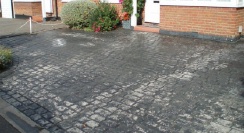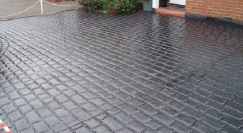CONCRETE SEALER AND CONDENSATION CAUSES WHITENING
Concrete sealer and condensation do not mix very well together. You've just applied a sealer to your beautiful decorative project.
When you look at it the next day you see white hazy patches all over the place. What happened?
 Sealer whitening before |
 Sealer whitening after fixed |
There is always water vapor in the air. The amount of vapor changes on a daily basis.
The term used to measure the amount of water vapor in the air is called humidity. Because of temperature fluctuations this vapor or gas doesn't always remain trapped in the air. Sometimes it changes to a liquid (condensation).
If temperature rises high enough and a lot of humidity is present it could rain. If temperatures fall, like on a cool summer evening, dew can form.
Have you ever walked on your grass in the morning and wondered why it was all wet? The dew point is the temperature at which water comes out of the air and changes to a liquid.
Concrete is like a sponge. It will absorb water from the air when it is very humid and it will also absorb water that comes into contact with its surface like dew.
What does this have to do with your decorative concrete you just put concrete sealer on?
Even though the concrete surface doesn't look wet, hiding just beneath it could be a lot of moisture. If a sealer is applied and traps this water a whitening effect could occur and the sealer may fail.
When sealing decorative concrete outside during high humidity conditions a dew can form on the sealer surface before it has cured properly.
This could trap water in the sealer after it cures out and a white haze will form.
You can try rewetting it with another light coat of sealer or spray a solvent like xylene or acetone on the surface to loosen the sealer and let the moisture escape.
If that doesn't work, there are different CHEMICAL STRIPPERS that can be used to remove the sealer and start over again.
My personal recommendation would be to seal the concrete with a penetrating sealer first. I use RadonSeal deep penetrating concrete sealer.
This would densify and harden the concrete plus waterproof the concrete by blocking all the internal pores. Not allowing moisture to be absorbed into the concrete.
You could leave it like this or use a topical sealer over it to bring out more of the color in a stamped concrete project.
Click on CONCRETE MOISTURE PROBLEMS for more causes and a solution to this whitening problem.
For information on other related concrete sealer topics click on the links below.
CONCRETE SURFACE TEMPERATURE CAN CAUSE SEALER PROBLEMS
DEICING SALTS AND CONCRETE SEALER PROBLEMS
WHAT CAUSES SEALER BLISTERS AND BUBBLES?
SEALER SURFACE PREPARATION BEFORE SEALING
IS THERE A TINTED SEALER I CAN USE?
WHAT KIND OF SEALER APPLICATOR SHOULD I USE?
Return From Concrete Sealer and Condensation to Concrete Sealer
Return From Concrete Sealer and Condensation to Everything About Concrete Home Page














